Genre: Sports Developer: Electronic Arts Publisher: Electronic Arts Players: 1-2 Released: 1990
I have to admit that it took me seemingly forever to finally understand and get into Budokan: The Martial Spirit. When the game first came out, I had no idea how to control the darn thing, and the only way I could find to win was to jump and strike my opponent’s head until he was knocked out of bounds three times. Cheap and easy, but completely against the whole purpose of the game. Back then however, it didn’t really matter, as most of my friends just laughed the game off and went back to playing Midnight Resistance. Few of them had every played PC games, so they weren’t aware of the origins of Electronic Arts’ tournament fighter.
That shouldn’t be a reason to dismiss Budokan though. Anyone who has enjoyed Data East’s Karate Champ should at least have some appreciation for this type of fighting. There’s no blood, fatalities, or graphic violence. No, Budokan came long before that. What we have here is straight-up competition, and all it takes is a little patience and training to be good enough to go all Daniel-san on your opponents.
The game starts the player in the Tobiko-Ryu Dojo. There, the sensei provides training in one of four disciplines: karate, kendo, bo staff, or nun-chucks. Each one has its own area for practice, and players can train alone, spar with a partner, or even take on their instructors. After each sparring session, the sensei will judge the player’s performance and recommend an expanded moveset if only a few were used. He’ll also compliment a good, diverse attack pattern. When enough is learned, would-be champions can leave the dojo and head to the Nippon Budokan arena to compete in a tournament against the world’s best fighters.
Practicing in the dojo is where players will iron out the wrinkles in their attack strategies and figure out the best combination of attacks to use. Trying them out in sparring sessions can be a bit fooling, however, as the actual tournament features many fighters boasting skills and weapons not found in the dojo. In addition to the four basic techniques, warriors brandish everything from naginatas to a sickle and chain. There’s even a ninja! I wondered how he was able to get into the tournament, and then I remembered he was a ninja. He probably murdered everyone working the door without making a sound, or he hid in the rafters until the end of the tournament. Either way, he’s there, and he’s a badass.
What makes the tournament so hard isn’t just that 16-bit karate masters are faced with techniques they’ve never seen before. Players have three attempts to defeat an opponent, and while this might seem like enough, it’s far harder than it sounds. Stepping too far out of the designated area on the matt leads to a fault that costs the fighter half his ki. Having this happen more than once against higher opponents can lead to a quick end to the fight.
The main problem with the actual combat is that players can only use each of their skills four times during the competition. Forget any ideas of using the bo staff all the way through, and eventually that stupid kendo stick is going to have to make an appearance. I would have liked to have the new skills open up after a certain amount of opponents were defeated, but it’s the same four styles to the end. The game boats a reported twelve styles in all (all based on authentic Japanese and Okinawan martial arts); pretty lame when one considers that only only a third of them are usable by the player.
I can see those who were raised on Street Fighter and Mortal Kombat taking an instant dislike to Budokan. There is absolutely no way to win by button mashing, and one must also consider that there are also ki and stamina bars with which to contend. Ki marks the amount of power used for each move, and doing a few power moves in succession will leave the player unable to do more than a few jabs until the bar refills. Blocking helps refill the bar, but this means that one must plan which moves to use before attacking. Stamina is also an issue, as doing too many moves can leave the player exhausted and vulnerable. Should the bar empty completely, the match ends in a loss. The control isn’t that bad once it becomes familiar, and through the use of the manual or a decent FAQ, it’s not as bad as clueless first impressions make it out to be.
I suppose that all the emphasis was placed on the presentation and animation, something Budokan does quite well. There are twenty-five moves per style, which makes for some fluid fighting. the dojos are all nicely rendered, with little details like birds feeding and tranquil fountains flowing in the background. The Genesis version lacks some of the color of its computer sibling, but the visuals are still very solid. It’s all quite functional, even the sound. Aside from the tweeting birds, there aren’t much more than a few “hiyah” and “hai!” yells throughout the game.
There’s a two-player mode, but it’s only available for sparring. Players must tackle the tournament alone, and I guess that works. This isn’t a traditional one-on-one fighter, and things aren’t really geared towards two-player action. Most of the time playing will be spent training in the dojo, and it probably wouldn’t be too fun to have one player sit and wait while the other figures out how to use specific attacks.
I think that Budokan, while revolutionary for its time, has been somewhat relegated to the background of the fighting scene since things went all hadoken and “FINISH HIM!” People don’t seem to have the patience to learn complex fighting techniques that don’t pay off in a spectacular explosion of death or million-hit combos. Those looking to actually put more time into combat than modern fighters permit will enjoy Budokan, and its low price and availability make it easy to find and dive into.
SCORE: 6 out of 10

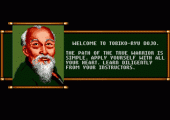
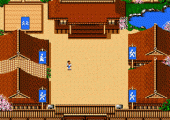
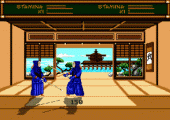
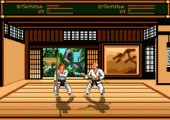
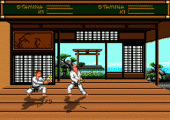
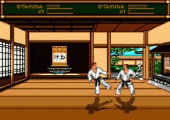
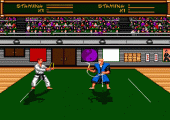
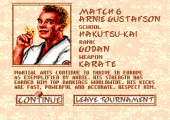
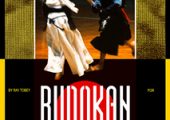
It’s interesting to see how fighting games used to be played before SF II came along to change the genre entirely. Instead of special moves and fast antics, these martial arts games had a more tactical air to them – rather than beating opponents life bar down over a time limit, you had to concentrate on landing the right attack at precisely the right moment. Early fighters like Budokan may look similar to more modern vs fighters, but they feel entirely different, slower and with more emphasis on tactics than all-out attacking.
(That isn’t to say that tactics aren’t important in more modern fighters as well, just that the focus of these games make them feel like they belong into an entirely different genre.)
I loved Budokan back in the day, but it hasn’t aged well. While I like how methodical and realistic it is, the controls are still incredibly stiff. Those charged moves are only useful against the poor AI as any human opponent can see the wind-up coming from a mile away. It’s a pretty game — I always liked the birds and whatnot in the dojo — but keeping a lot of that variety and detail locked behind the single player tournament hurts.
Budokan’s probably better known now for being one of the three early EA games made unplayable on the most Genesis systems due to Sega’s hardware revisions. I don’t think people are missing out too much, and I agree that it has little to offer compared to the system’s better fighting games.
I truly love it but I totally understand that it’s not for everyone. Budokan is actually a martial-arts sim rather than a traditionnal fighting game. It requires a lot of practice and focus. It was also one of my first games on the PC, a true classic and a very challenging video game.